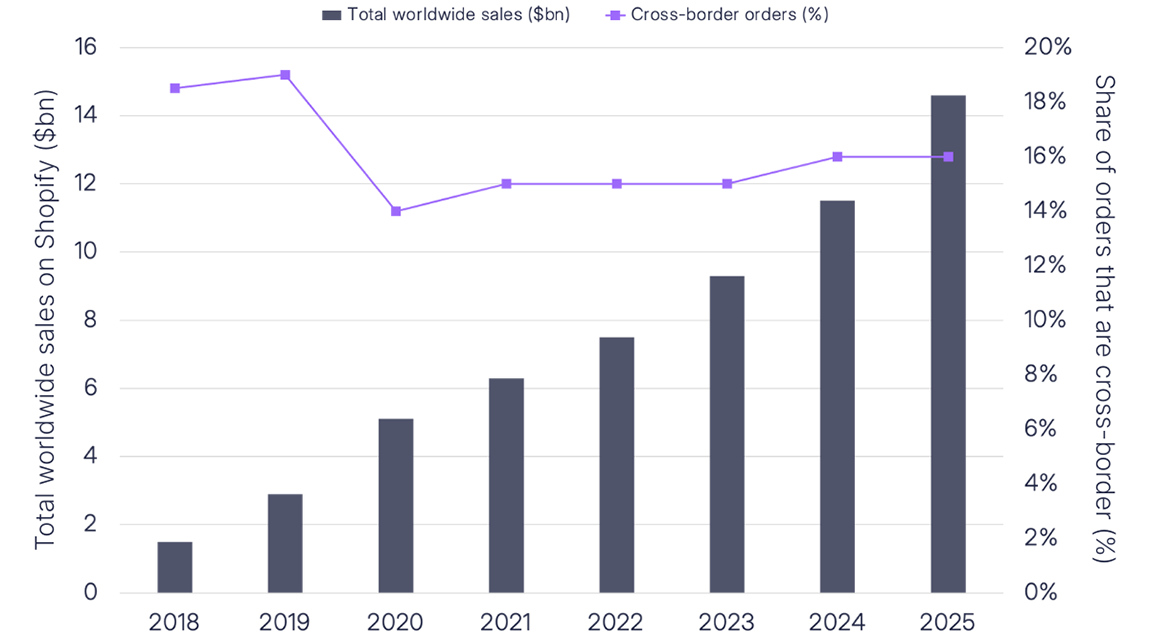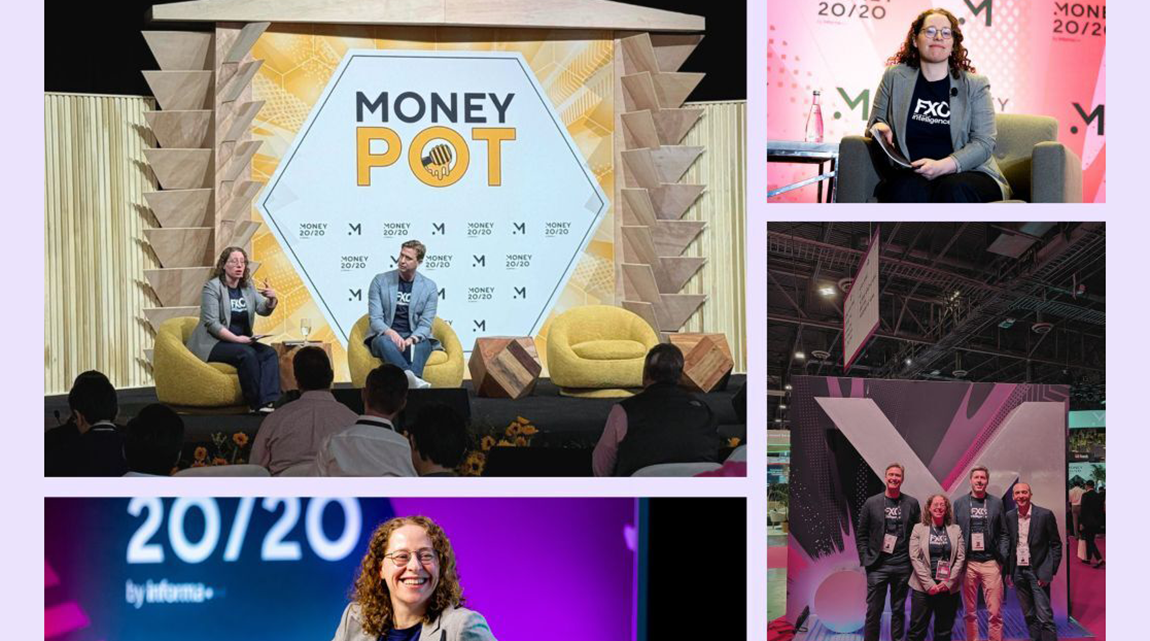Influencer gifting, and in particular the use of in-app gifts such as virtual stickers, has gained increasing popularity this year. But how much money do creators receive from their followers’ payments?
Influencer gifting has been on the rise for some time, but in 2023 it reached new heights in use and attention. The practice of social media followers sending virtual gifts to their favourite creators – who can then convert them into cash pay-outs – is now available across a broad range of social media platforms, as part of a growing suite of solutions for influencers to make money.
This year, however, it gained unprecedented mainstream attention as a result of a number of social media trends. Most notable of these was the TikTok NPC trend, which sees streamers narrate stickers sent by followers in real-time, in imitation of a video game non-playable character. The practice may seem bizarre from the outside, but with each sticker coming with a monetary pay-out value, it has reportedly netted some streamers thousands of dollars per hour.
While these gifts come with benefits, such as the increased chance of a response to a message from an influencer, they ultimately represent a monetary present from fan to creator. And with the festive season now well underway, many social media users will be doling out such gifts to their favourite accounts.
With creators and fanbases being global in nature, many of these gifts ultimately represent cross-border payments facilitated by the social media platforms. However, with the transfer of funds often shrouded in multiple stages of virtual tokens, the precise financial mechanisms of such gifts is often unclear.
This report looks at the multiple steps in many of the major influencer gifting programmes offered by social media companies to determine how they vary in terms of structure and transparency, as well as how much influencers receive from followers’ initial payments. It covers programmes offered by Facebook, Instagram, Reddit, Snapchat, TikTok and YouTube, providing direct comparisons where possible.
The main token-based influencer gifting programmes
Across the six different social media platforms covered in this report, most provide multiple ways for creators to earn money. However, for the purposes of this report, we will be focusing on the token-based gifting programmes offered by these companies.
These all have some commonalities, in that users convert fiat cash into app or platform-based tokens, which are then either given directly or converted into another form to give to influencers. The influencers are then able to convert them back into fiat cash, either directly or via an additional token.
These gifts are typically designed to bring benefits beyond a direct transfer of value, such as increased interaction or visibility between follower and creator. However, for many creators these serve primarily as a way to directly earn money from follower actions, as opposed to other programmes where a creator may have fewer direct opportunities to influence the amounts they earn, such as revenue share from adverts.
On the Meta-owned social media platforms, gifts take the form of Stars tokens, via the Facebook Live Gifts programme and the Instagram Gifts programme. While both essentially use the same token, these are not transferable between the two apps and there are minor differences in how they can be used across the two platforms. On Instagram, creators can also receive money through the sale of Instagram Badges, which are paid out in a similar way to Stars but do not involve a token system. In all cases, the focus is on sending gifts to creators that followers engage with.
Reddit, meanwhile, is one of the few platforms where its token system is the sole way for creators to make money on the platform, as a result of a recent revamp of its long-running Reddit Gold system. While only fully rolled out in the US, this enables users to earn Gold from eligible posts and comments, prioritising high-quality interactions on the platform. This sets it apart from other social media platforms as creators do not have to cultivate the same influencer status; the focus is on a reward for well-received content, rather than a gift to the individual.
Snapchat and Tiktok, meanwhile, have highly similar token-based gifting programmes. In both cases, this is one of a wide range of ways approved creators can earn money through the platforms, all of which feed off the need to develop significant, engaged audiences. In both cases, users purchase initial tokens (Snap Tokens on Snapchat, Coins on Tiktok) that can be used for multiple applications on the platform, including the purchase of virtual gifts for creators. When received, these are converted into a creator-specific token (Crystals on Snapchat and Diamonds on TikTok) that is used to reward multiple creator activities on the platform. These are then converted into fiat money by the creators.
Finally, while YouTube has a number of ways that creators can monetise content, its gift programme allows users to directly purchase virtual gifts for their favourite creators, which are then converted into a fiat-based balance that creators can withdraw.
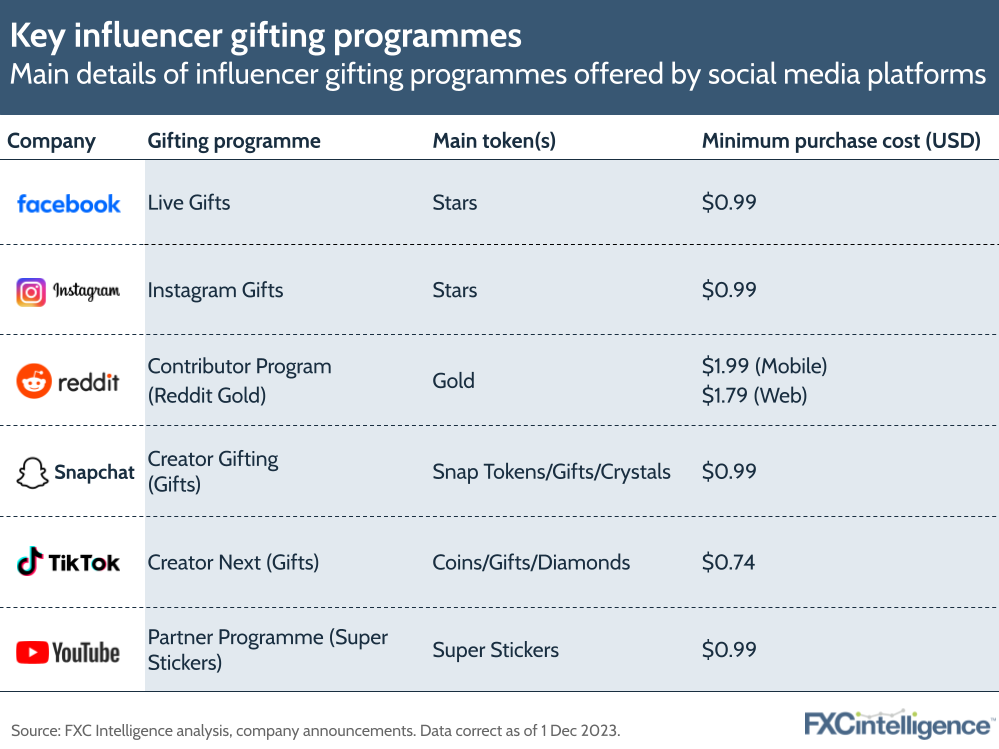
Tokens and conversions: How gift processes compare across different social media platforms
While all of the programmes compared in this report use some form of token, these vary significantly in terms of pay-in to pay-out complexity between social media platforms.
At the simplest end of the spectrum is YouTube, where users buy gifts in fiat for specific creators, who can then get their value paid to their chosen account. Next is Reddit, where users buy Gold either individually or in a bundle and then gift it to their chosen recipient; the recipient then gets it converted back into its equivalent fiat value and paid out.
Facebook and Instagram are marginally more complex, using Stars tokens, which are then converted into gifts, or in the case of Facebook sent directly, before being converted back into Stars for conversion and pay-out.
At the most complex end of the scale, Snapchat and TikTok both use a three-step system, like Instagram, but utilise two different sets of tokens at the user and creator end. Their programmes see users buy one set of tokens, which are converted into gifts to send to creators before being converted into a different set of tokens exclusively used by creators.

Digital ‘stickers’ are a common form of gift on a number of platforms, with fixed values in either fiat (in the case of YouTube) or the token purchased by users (in the case of TikTok and Snapchat). In the case of the latter, these are often priced in a way where their value in fiat currency is not immediately clear, particularly as users may purchase the original tokens in quantities that are not easy to do conversions with.
For example, TikTok advertises Coins in units of 70, 350, 700, 1,400, 3,500, 7,000 and 17,500, as well as allowing custom purchases of larger amounts. These Coin values are equivalent to $0.74, $3.70, $7.40, $14.80, $37, $74 and $184. Following this, users then can buy around 100 different Gifts that are priced at a wide range of points between 10 and 1,999 Coins – equivalent to around $0.11 and $21.
By contrast, Snapchat sells Tokens in bundles of 80, 250, 500 and 1,100 – equivalent to $0.99, $2.99, $4.99 and $9.99 – and sells Gifts at price points between 50 and 1,000 Tokens. This means that users are purchasing Gifts for the equivalent of between around $0.62 and $12.33.
YouTube, meanwhile, prices its gifts in local currency, and while it offers a large number at low price points of $2 or below, it also has gifts at much higher price points than TikTok or Snapchat, with the largest gifts being $50 or the local equivalent.
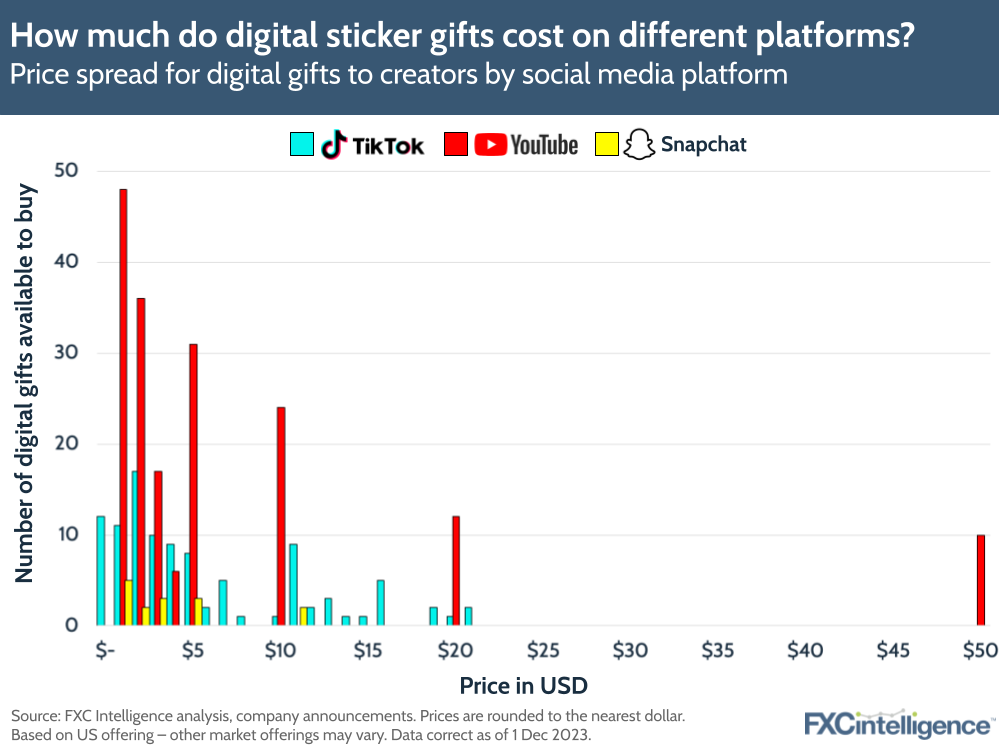
How transparent are different social media platforms about the cost of influencer gifts?
The use of any form of token inevitably reduces the transparency of the process compared to a direct payment to a creator in a single currency. However, in reviewing the processes across the six different platforms, we found that there was significant variation in the transparency of social media gifts to influencers.
For this report, we assessed each platform across three areas: pricing, use of conversions and pay-outs.
For the first, we looked at whether the pricing was clearly communicated, and whether followers were getting a better price-per-unit if they purchased larger numbers of tokens. For the second, we reviewed how the use of multiple step processes and conversions between these reduced transparency in the process. And for the third, we looked at how easy it was for followers to find out how much of their initial payment ultimately went into creators’ accounts.
The best performing company here was YouTube, where clearly communicated gift prices at the point of purchase, as well as a single-token system and easy-to-find information about the amounts paid to creators, led to us scoring the company as having high transparency across all three metrics.
Facebook and Instagram, meanwhile, gave clear discounts for multiple purchases of tokens, and the use of the same token for both gifters and creators reduced potential confusion. The only area these companies saw reduced scores was on the pay-out side as, while it is possible for followers to find out what share of their payment goes to creators, this information required considerably more effort to find than the average user is likely to undertake.
Reddit scored well on the simplicity of its gifting system, and similarly received a mid-point score for its transparency on pay-out fees, however its worst performing area was on its pricing for tokens. While the company does list multiple tiers of pricing for different quantities of gold, these are priced so that the cost-per-unit increases as you buy more, rather than reducing. This is in direct contradiction to what consumers are likely to assume, and is not clear without individually calculating each price point.
TikTok, meanwhile, is not more expensive for larger numbers of Coins, but is not cheaper either – instead the cost-per-unit remains the same no matter what quantity a user purchases, and the three-step system with conversion into a different pay-out token further complicates the process. Pay-out rates are published, but again require research to find.
However, the worst scoring for transparency was Snapchat. While the company has bundles of its pay-in token that see the cost-per-unit reduce with larger purchases, it uses a complex three-step token system where there is no publicly available information about the conversion rates between these, meaning it is not possible to determine how much of a follower Gift an influencer will receive on the platform.
Attempts to clarify this via Snap’s media team have been unsuccessful. We also asked the in-app Snapchat AI how much a specific Gift was worth to creators in Crystals, and was told it “doesn’t have a specific value” and that the value would “depend on the sender’s intention and the recipient’s appreciation”, with the AI adding that “it’s more of a fun and expressive way to show your excitement and support”.
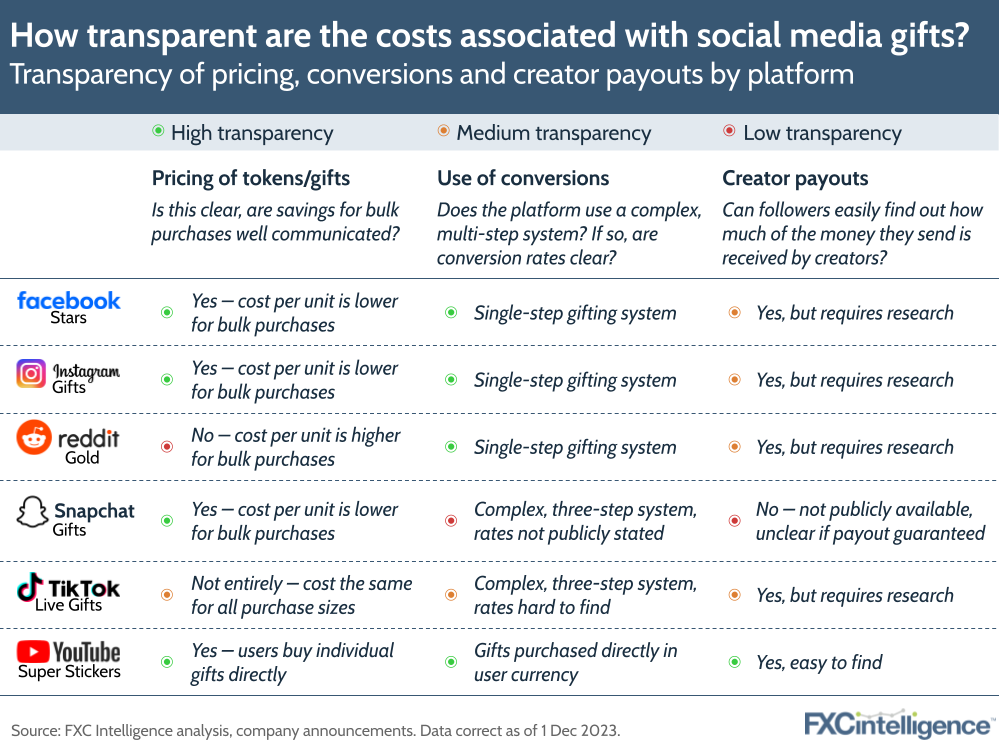
How much money do creators receive from social media payments?
Pay-outs to creators vary across several metrics between different platforms, although there are commonalities across most. In most cases, pay-outs are in US dollars only, meaning that those receiving pay-outs to non-US accounts are likely to incur a currency conversion fee. In addition, some platforms – namely Snapchat, TikTok and Reddit – charge additional fees to withdraw money, in addition to the cuts they take from followers’ initial send amounts.
In all cases, there is a considerable delay between a gift being sent and a creator receiving their pay-out. Many companies will only pay out when a certain balance has been reached, and will then make a payment at a set date or window in the following month.
These balances also mean pay-outs generally require creators to have accrued significant numbers of gifts, with balances of $100 or more required by Facebook, Snapchat and YouTube, as well as for Instagram’s non-US creators.
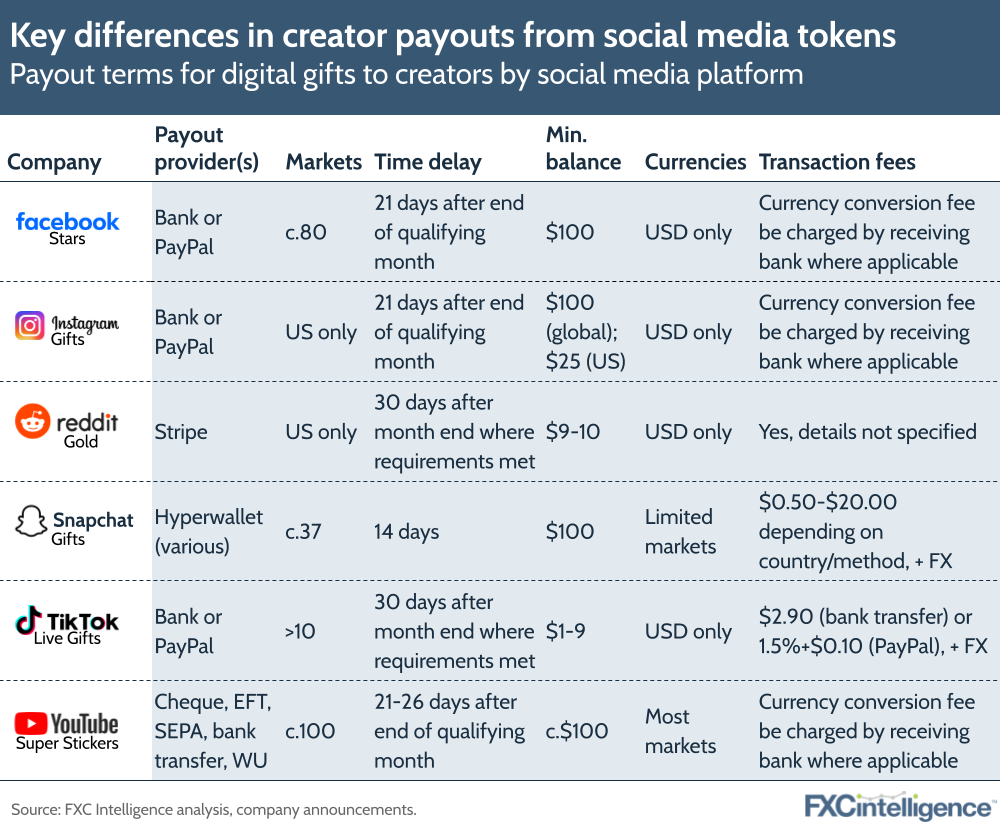
While it is not possible to calculate the margin charged by Snapchat as the company does not publish sufficient information, for the others we can calculate how much creators ultimately receive from their gifts, minus any pay-out fees.
Here, YouTube has the best pay-out rates for creators, who receive 70% of gifts, with YouTube taking a 30% cut. For the others, the number mostly sits at around 50%, with variation based on the price users purchase their initial tokens for, as well as whether creators are on more favourable pay-out terms, such as those offered by Reddit to some creators.
Facebook offers the biggest range – between 49% and 64% is received by the creator – giving the social media a platform a cut of 36-51%, followed by Reddit with a range of 50-56% to creators (44-50% to the platform) and Instagram with a range of 45-50% to creators (50-55% to the platform). TikTok, meanwhile, always takes a 50% cut.
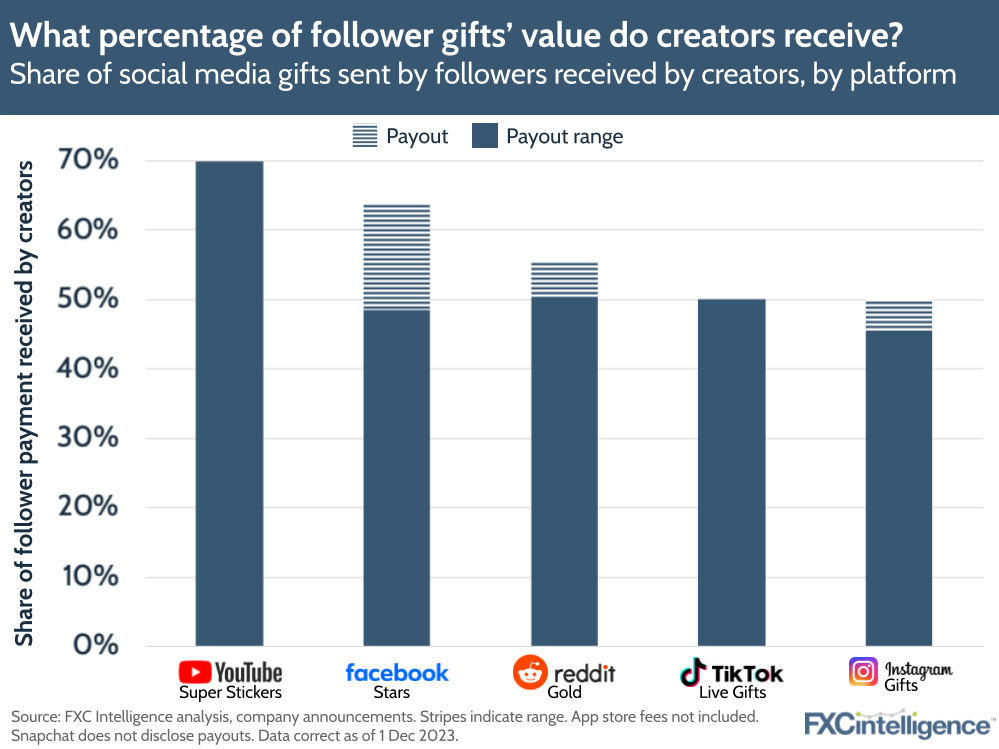
Beyond influencer gifting: Alternative approaches to creator payments
If followers are sending gifts solely to provide their favourite creators with funding, then these platforms represent very high margins for the service, with the most favourable, YouTube, taking a 30% cut.
While such services offer additional interaction benefits, those looking purely for this financial transfer may be better off employing other platforms that offer far smaller margins, and so ensure that larger amounts of the money ultimately end up in the accounts of the creators.
Here there are a variety of options, which vary in availability depending on the operating status and geography of the creator and follower. For simple payments to individuals, such as tips, Cash App, Ko-Fi, PayPal and Venmo all offer solutions with zero fees, although for Cash App and Venmo these are largely restricted to the US, which limits their use for creators who often are either based internationally or have large international followings.
For more complex payments that are more closely tied to content, creators have options that include Ko-Fi and Patreon, with the latter taking the highest margin, at 8-12% – still considerably lower than the smallest in this report.
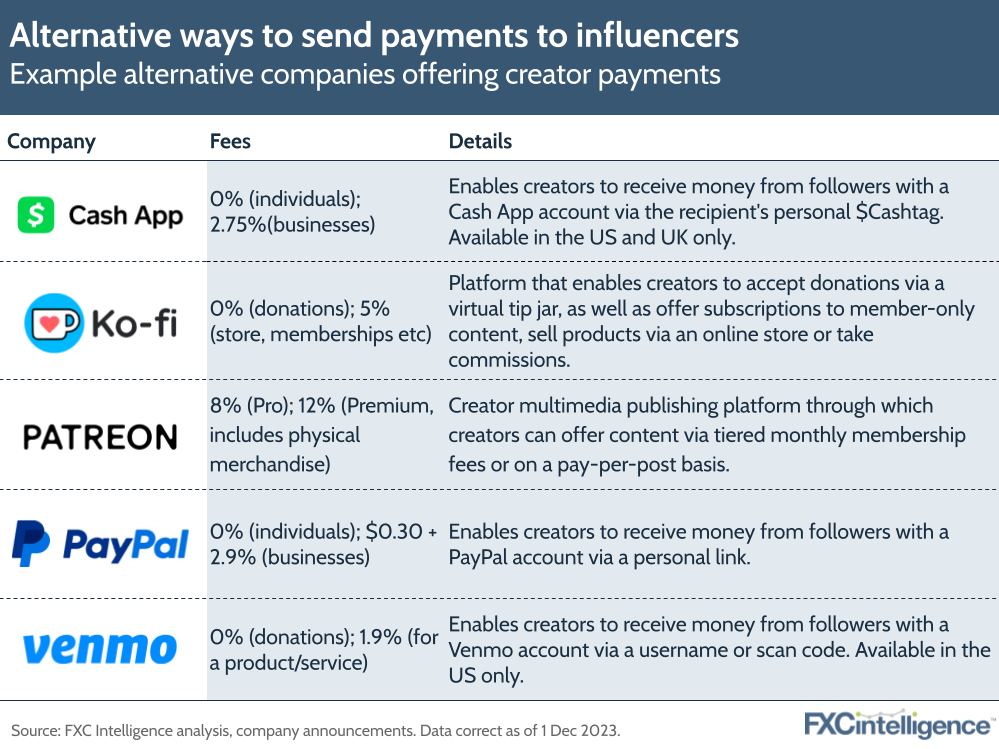
Notably, however, creators using these platforms typically still rely on social media to gain followers and reach, and the convenience and ease that social media gifts provide is likely to increase their use over external solutions. However, for followers who want to make sure that as much of their gift is received as possible, other alternatives may be a better fit.

